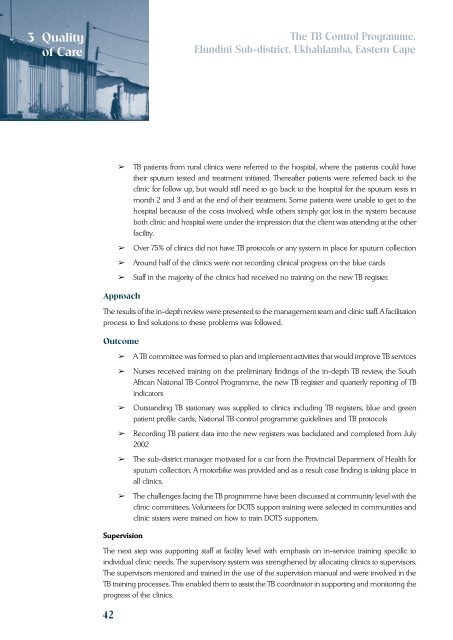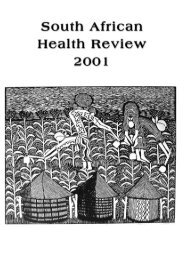Lesson learnt in the implementation of PHC - Health Systems Trust
Lesson learnt in the implementation of PHC - Health Systems Trust
Lesson learnt in the implementation of PHC - Health Systems Trust
You also want an ePaper? Increase the reach of your titles
YUMPU automatically turns print PDFs into web optimized ePapers that Google loves.
3 Quality<br />
<strong>of</strong> Care<br />
The TB Control Programme,<br />
Elund<strong>in</strong>i Sub-district, Ukhahlamba, Eastern Cape<br />
➢<br />
➢<br />
➢<br />
➢<br />
TB patients from rural cl<strong>in</strong>ics were referred to <strong>the</strong> hospital, where <strong>the</strong> patients could have<br />
<strong>the</strong>ir sputum tested and treatment <strong>in</strong>itiated. Thereafter patients were referred back to <strong>the</strong><br />
cl<strong>in</strong>ic for follow up, but would still need to go back to <strong>the</strong> hospital for <strong>the</strong> sputum tests <strong>in</strong><br />
month 2 and 3 and at <strong>the</strong> end <strong>of</strong> <strong>the</strong>ir treatment. Some patients were unable to get to <strong>the</strong><br />
hospital because <strong>of</strong> <strong>the</strong> costs <strong>in</strong>volved, while o<strong>the</strong>rs simply got lost <strong>in</strong> <strong>the</strong> system because<br />
both cl<strong>in</strong>ic and hospital were under <strong>the</strong> impression that <strong>the</strong> client was attend<strong>in</strong>g at <strong>the</strong> o<strong>the</strong>r<br />
facility.<br />
Over 75% <strong>of</strong> cl<strong>in</strong>ics did not have TB protocols or any system <strong>in</strong> place for sputum collection<br />
Around half <strong>of</strong> <strong>the</strong> cl<strong>in</strong>ics were not record<strong>in</strong>g cl<strong>in</strong>ical progress on <strong>the</strong> blue cards<br />
Staff <strong>in</strong> <strong>the</strong> majority <strong>of</strong> <strong>the</strong> cl<strong>in</strong>ics had received no tra<strong>in</strong><strong>in</strong>g on <strong>the</strong> new TB register.<br />
Approach<br />
The results <strong>of</strong> <strong>the</strong> <strong>in</strong>-depth review were presented to <strong>the</strong> management team and cl<strong>in</strong>ic staff. A facilitation<br />
process to f<strong>in</strong>d solutions to <strong>the</strong>se problems was followed.<br />
Outcome<br />
➢<br />
➢<br />
➢<br />
➢<br />
➢<br />
➢<br />
A TB committee was formed to plan and implement activities that would improve TB services<br />
Nurses received tra<strong>in</strong><strong>in</strong>g on <strong>the</strong> prelim<strong>in</strong>ary f<strong>in</strong>d<strong>in</strong>gs <strong>of</strong> <strong>the</strong> <strong>in</strong>-depth TB review, <strong>the</strong> South<br />
African National TB Control Programme, <strong>the</strong> new TB register and quarterly report<strong>in</strong>g <strong>of</strong> TB<br />
<strong>in</strong>dicators<br />
Outstand<strong>in</strong>g TB stationary was supplied to cl<strong>in</strong>ics <strong>in</strong>clud<strong>in</strong>g TB registers, blue and green<br />
patient pr<strong>of</strong>ile cards, National TB control programme guidel<strong>in</strong>es and TB protocols<br />
Record<strong>in</strong>g TB patient data <strong>in</strong>to <strong>the</strong> new registers was backdated and completed from July<br />
2002<br />
The sub-district manager motivated for a car from <strong>the</strong> Prov<strong>in</strong>cial Department <strong>of</strong> <strong>Health</strong> for<br />
sputum collection. A motorbike was provided and as a result case f<strong>in</strong>d<strong>in</strong>g is tak<strong>in</strong>g place <strong>in</strong><br />
all cl<strong>in</strong>ics.<br />
The challenges fac<strong>in</strong>g <strong>the</strong> TB programme have been discussed at community level with <strong>the</strong><br />
cl<strong>in</strong>ic committees. Volunteers for DOTS support tra<strong>in</strong><strong>in</strong>g were selected <strong>in</strong> communities and<br />
cl<strong>in</strong>ic sisters were tra<strong>in</strong>ed on how to tra<strong>in</strong> DOTS supporters.<br />
Supervision<br />
The next step was support<strong>in</strong>g staff at facility level with emphasis on <strong>in</strong>-service tra<strong>in</strong><strong>in</strong>g specific to<br />
<strong>in</strong>dividual cl<strong>in</strong>ic needs. The supervisory system was streng<strong>the</strong>ned by allocat<strong>in</strong>g cl<strong>in</strong>ics to supervisors.<br />
The supervisors mentored and tra<strong>in</strong>ed <strong>in</strong> <strong>the</strong> use <strong>of</strong> <strong>the</strong> supervision manual and were <strong>in</strong>volved <strong>in</strong> <strong>the</strong><br />
TB tra<strong>in</strong><strong>in</strong>g processes. This enabled <strong>the</strong>m to assist <strong>the</strong> TB coord<strong>in</strong>ator <strong>in</strong> support<strong>in</strong>g and monitor<strong>in</strong>g <strong>the</strong><br />
progress <strong>of</strong> <strong>the</strong> cl<strong>in</strong>ics.<br />
42

















